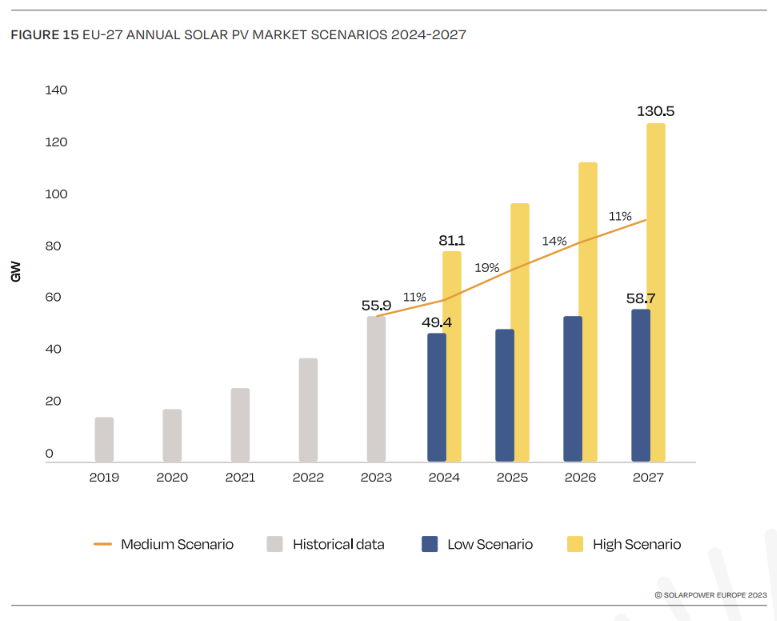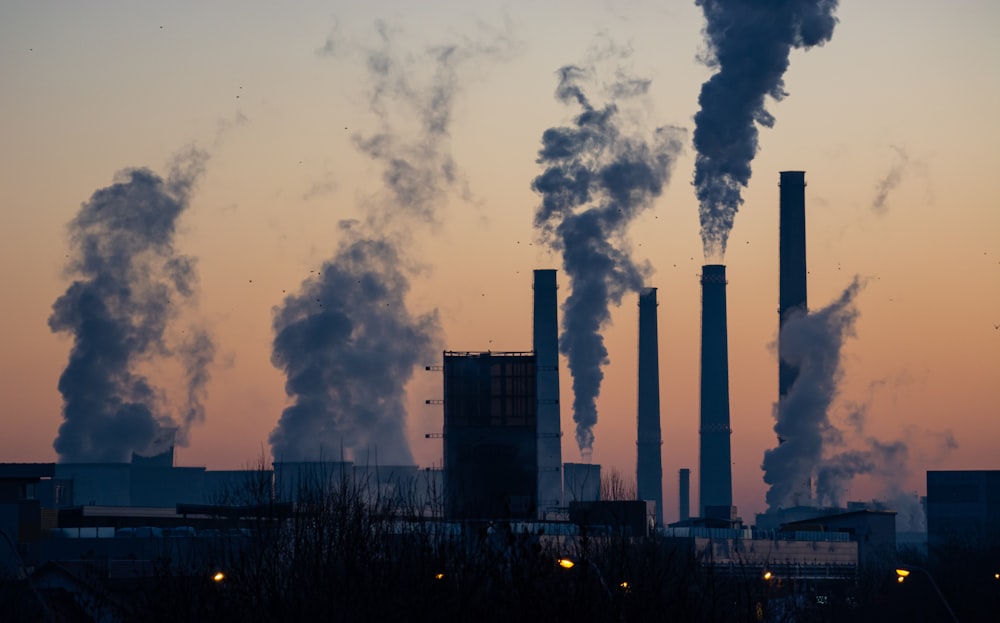The rate of change
Gaining an edge in any market comes not from paying attention to absolute levels, but rather by focusing on the rate of change (ROC) in prices, fundamentals, and how they intersect.
Over the past twelve months, the EU carbon market has been buffeted by strong growth in renewable generation (particularly solar), the return of French nuclear capacity from its 2022 nadir, the return to pre-energy crisis gas and power prices, and a slump in European industrial production - particularly evident in the energy intensive chemical sector.
Even if these trends continue through 2024, the ROC is unlikely to be a high as that which unfolded in 2023. That may present an opportunity for investors looking for a longer-term entry point into the EU carbon market.
Lets look at one of the largest contributors to EU emissions ROC in 2023. The growth in installed EU solar PV capacity. According to data compiled by SolarPower Europe 55.9 GW of new capacity was installed across the EU-27 in 2023, an increase of 40% on the previous year. It marks the third year in a row that annual installed capacity has increased by at least 40% and has been led by installations in Germany and Spain. Across Europe an estimated 263 GW of cumulative solar PV capacity is installed. That’s up 27% y-o-y, and represents an acceleration in the annual growth rate from the 24% seen in 2022 and 20% in 2021.1
One of the most important factors underpinning the surge in EU solar PV capacity has been the sharp increase in wholesale and domestic energy prices over the past couple of years combined with the fear - stoked by the Russian invasion of Ukraine - that energy shortages might develop. However, as SolarPower Europe make clear, as electricity and gas prices began to fall dramatically during 2023 there has been a marked slowdown in demand for solar PV installations. Permitting delays and a shortage of engineers has increased the time lag between the decision to install and the capacity actually coming onstream, and so we’re still seeing some of that residual demand resulting from the energy crisis.
Twelve months ago SolarPower Europe published their outlook for EU27 solar PV installation in 2023. Their central scenario was for an additional 53.6 GW in capacity, just shy of the eventual outturn (see In the shade: Europe's solar power does not get the credit it deserves). In their latest report, which details projections for the period 2024-2027, the group expect capacity growth to slow significantly as the urgency to install - at least from an energy price risk and security perspective - is all but gone. Rather than a shortage of engineers being the main challenge in 2024 and 2025, SolarPower Europe believe that power networks now require time to adjust to the growth in the share of solar in the generation stack.
Although their central scenario is for PV installations to increase by 11% to 62 GW in 2024, their low scenario (one that they weight a higher probability to than past outlooks) would see annual installations drop to 49.4 GW in 2024. If the latter scenario unfolds it would still represent a 19% increase inn EU-27 solar PV capacity to 312 GW. But importantly, the ROC has slowed dramatically relative to the experience over the past few years.
As I highlighted in Carbonomics 2023: Chinese EV battery deflation offsets offshore wind cost inflation, Europe’s reaction to geopolitical concerns could scupper the bloc’s ability to meet its climate targets, and that includes the rollout of solar PV capacity. Right now more than 90% of Europe’s demand for wafers and other solar PV components are imported from China. The glut of cheap imports has been a boon for Europe’s installers and utility scale generators, but it hasn’t been so nice for Europe’s solar PV manufacturing industry where many companies have been gone bankrupt. If the EU responds with import tariffs and government purchases of surplus EU manufactured stock (which is dearer than Chinese imports), it will only make it more expensive to meet the EU’s renewable and emission targets, while also being no guarantee of a future burgeoning European solar PV industry.
A double digit increase in solar PV capacity across Europe may sound like good news for the climate, and bad news for the price of carbon, but that isn’t necessarily true. Remember that the annual decline in the EU ETS emissions cap accelerates to 4.3% from next year (from 2.2% currently), there is a one-off ‘rebasing’ of the cap in 2024 (reducing it by 90 million EUAs), while the Market Stability Reserve (MSR) continues to stow away 24% of the total number of EUA’s in circulation each year, leaving less available to utilities and industrial emitters to meet compliance.
Rather than base your outlook on absolutes, much better to focus on the ROC.
Smoke signals
The opening line of a recent article in The Economist begins, “When Europeans turn their attention to what markets have to say, it is usually because trouble is brewing.” From the spread between Italian and Greek bond yields over those issued by the German government, European natural gas prices, to the value of the Euro versus the dollar. In times of crisis past and present, investors, politicians, and the media tend to focus on what these markets are signalling about the health of the European economy and political environment.
https://www.solarpowereurope.org/insights/outlooks/eu-market-outlook-for-solar-power-2023-2027#download







